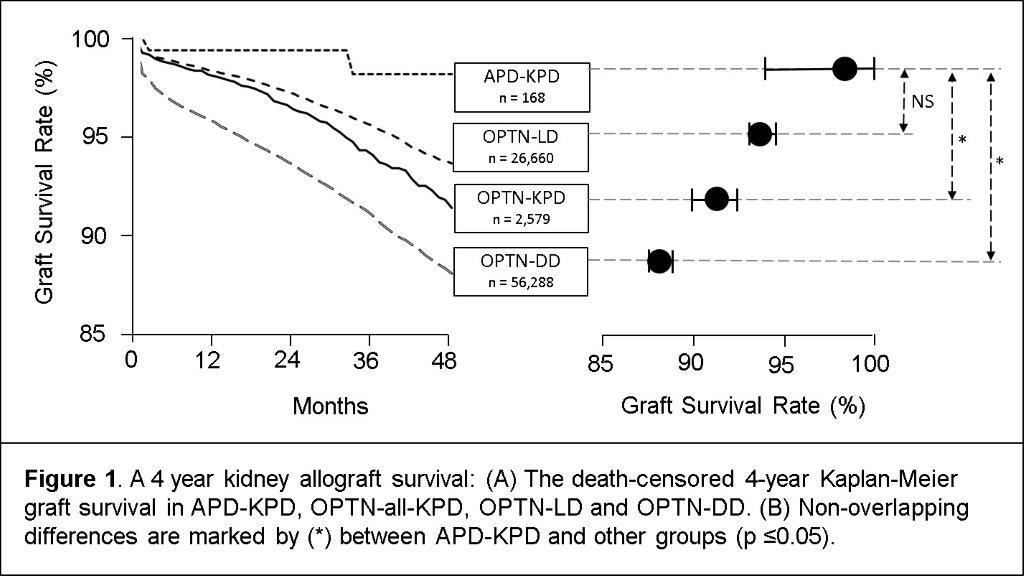Benefits of Expanding Options for Patients Registered in the Kidney Paired Donation Program.
University of Toledo, Toledo, OH
Meeting: 2017 American Transplant Congress
Abstract number: A243
Keywords: Graft survival, Kidney transplantation
Session Information
Session Name: Poster Session A: Living Donor Kidney Transplant I
Session Type: Poster Session
Date: Saturday, April 29, 2017
Session Time: 5:30pm-7:30pm
 Presentation Time: 5:30pm-7:30pm
Presentation Time: 5:30pm-7:30pm
Location: Hall D1
Introduction: Kidney Paired Donation (KPD) programs play an important role in facilitating exchanges of incompatible donors. We reviewed the outcome of 1121 patients who were registered during a 6-year period in our KPD (the Alliance for Paired Donation; APD). Methods/Results: Of all registered patients, 712 (64%) were transplanted: 409 (37%) by KPD (223 by APD-KPD and 186 by KPD outside the APD), 110 (10%) by transplants from compatible live donors (APD-LD), and 193 (17%) by transplants from deceased donors (APD-DD). We compared results of APD versus OPTN transplants from the same period. Among APD-registered patients 41% were highly sensitized (cPRA 80-100%) and 30% were highly sensitized (cPRA 95-100%). However, highly sensitized patients accounted for only 22% of APD-KPD transplants (half of which were very highly sensitized). This disparity was responsible for an accumulation of highly sensitized patients in the program. The death-censored 4-year graft survival was 98.2% in APD-KPD compared to 91.4%, 93.7%, and 88.1% for all OPTN-KPD programs, for OPTN-LDs, and for OPTN-DDs, respectively (fig.1).  APD-KPD patients had an excellent 6-year up-to-date graft survival in non-sensitized (94.8%; cPRA 0-19%; n=115), as well as in mildly (98.1%; cPRA=20-19%; n=53), highly (93.9%; cPRA=80-100%; n=49) and very highly (96%; cPRA=95-100%; n=25) sensitized patients. Similarly, the 6-year up-to-date graft survival was 93% for APD-other-KPD, 92% for APD-LD and 82% for APD-DD. Immunosuppression in APD-KPD patients consisted of calcineurin inhibitors, mycophenolates and steroids, combined with induction therapy. In highly sensitized patients, 83% were treated with rabbit anti-thymocyte globulin and 6% with alemtuzumab vs 60% and 6%, respectively, in OPTN-KPD patients. Conclusions: 1) APD-registered patients received transplants through different options (KPD, LD, and DD) which significantly expanded the pool of donors for highly sensitized patients; 2) APD-KPD transplanted patients had excellent survival results which may be attributed to the use of potent induction therapy and good donor/recipient matching.
APD-KPD patients had an excellent 6-year up-to-date graft survival in non-sensitized (94.8%; cPRA 0-19%; n=115), as well as in mildly (98.1%; cPRA=20-19%; n=53), highly (93.9%; cPRA=80-100%; n=49) and very highly (96%; cPRA=95-100%; n=25) sensitized patients. Similarly, the 6-year up-to-date graft survival was 93% for APD-other-KPD, 92% for APD-LD and 82% for APD-DD. Immunosuppression in APD-KPD patients consisted of calcineurin inhibitors, mycophenolates and steroids, combined with induction therapy. In highly sensitized patients, 83% were treated with rabbit anti-thymocyte globulin and 6% with alemtuzumab vs 60% and 6%, respectively, in OPTN-KPD patients. Conclusions: 1) APD-registered patients received transplants through different options (KPD, LD, and DD) which significantly expanded the pool of donors for highly sensitized patients; 2) APD-KPD transplanted patients had excellent survival results which may be attributed to the use of potent induction therapy and good donor/recipient matching.
CITATION INFORMATION: Stepkowski S, Mierzejewska B, Belbolsynov D, Baum C, Kopke J, Brunner R, Rees S, Rees M. Benefits of Expanding Options for Patients Registered in the Kidney Paired Donation Program. Am J Transplant. 2017;17 (suppl 3).
To cite this abstract in AMA style:
Stepkowski S, Mierzejewska B, Belbolsynov D, Baum C, Kopke J, Brunner R, Rees S, Rees M. Benefits of Expanding Options for Patients Registered in the Kidney Paired Donation Program. [abstract]. Am J Transplant. 2017; 17 (suppl 3). https://atcmeetingabstracts.com/abstract/benefits-of-expanding-options-for-patients-registered-in-the-kidney-paired-donation-program/. Accessed December 18, 2025.« Back to 2017 American Transplant Congress
